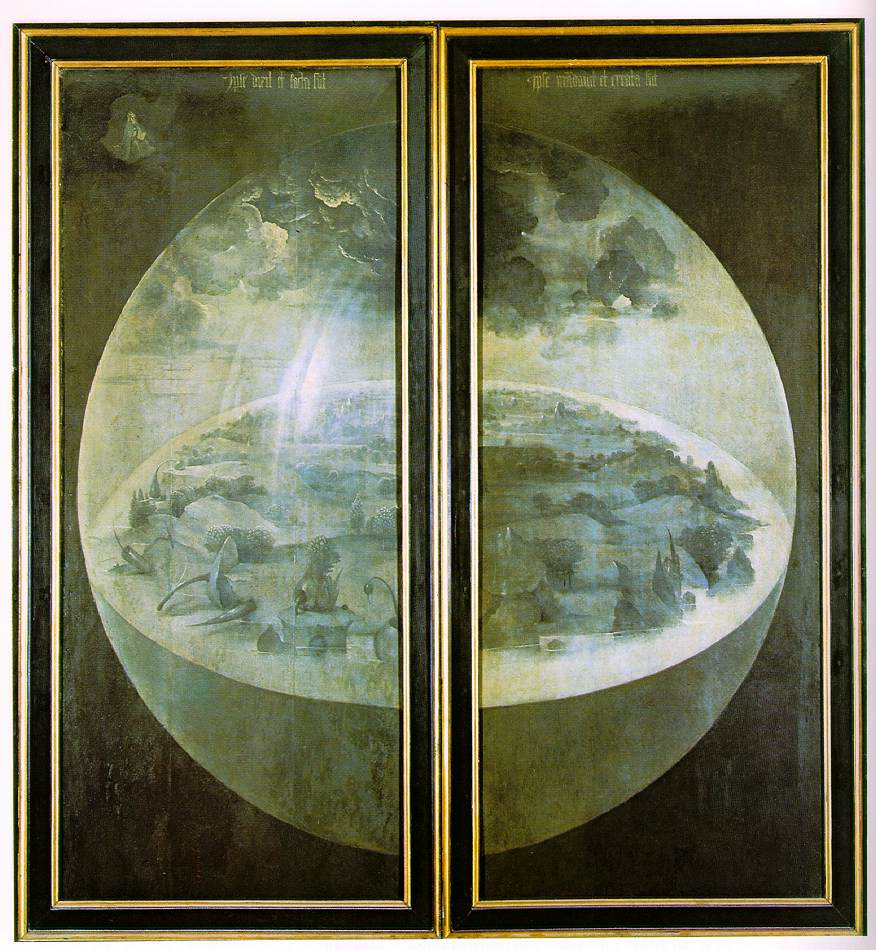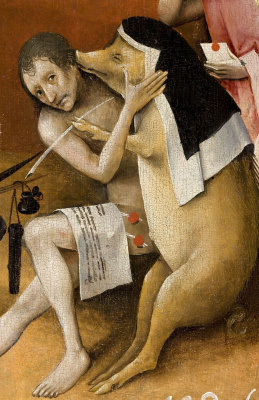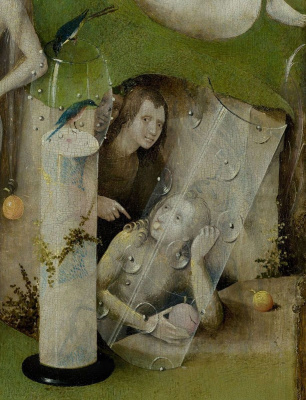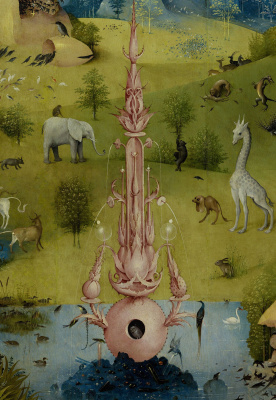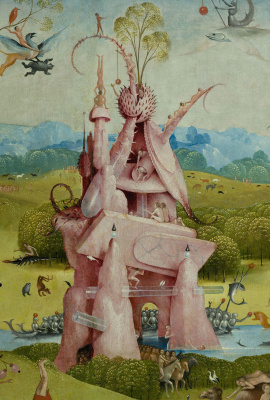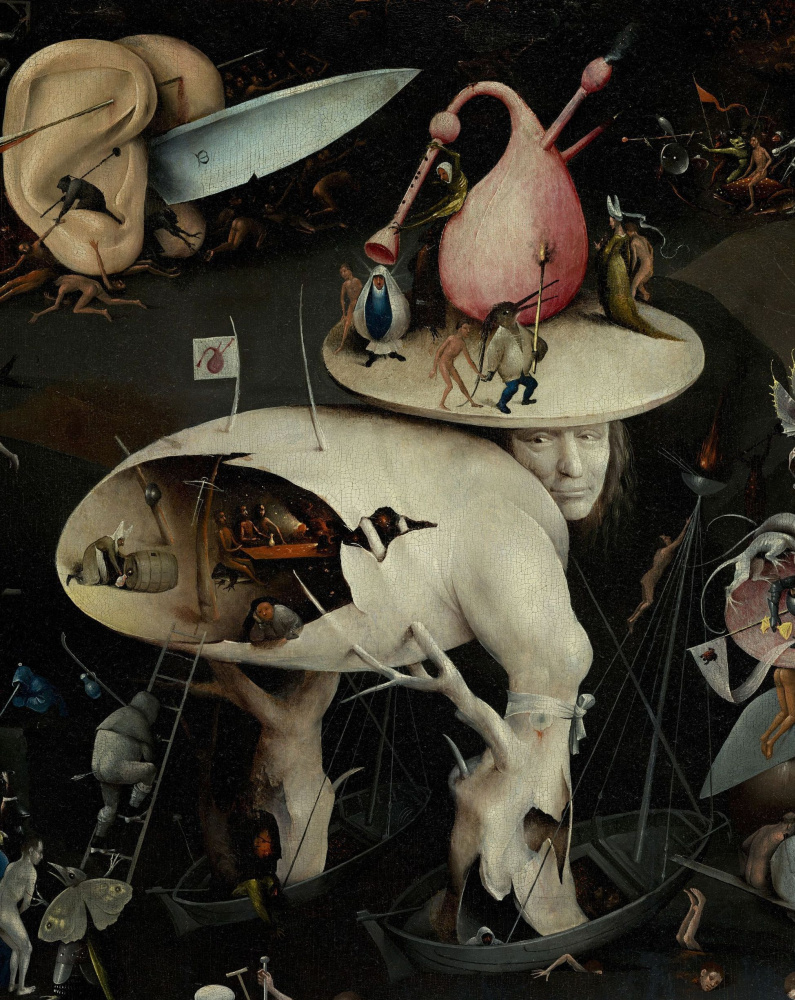The garden of earthly delights. The Creation Of The World. External doors
1500-th
, 220×195 cm
Perhaps in the history of painting there was no other character whose personality would have caused such a lively interest among the general public and at the same time would have been shrouded in such thick fog. Certainly, little is known about Hieronymus Bosch - historians do not even know the exact date of his birth. And where facts are lacking, bold hypotheses reign.
The garden of earthly delights
1500-th
, 220×390 cm
In a sense, Bosch’s biography is similar to his famous triptych “The Garden of Earthly Delights”. In the "closed" form - this is a scanty monochrome list of archival documents. But it is worth art critics to open the wings of imagination, and Bosch's life blooms with the most incredible events, colors and images.
In fact, who was this amazing person? Messiah, antichrist, visionary, madman, or maybe all of this at once? Here are the most popular versions, disturbing the minds of researchers for several centuries.
In fact, who was this amazing person? Messiah, antichrist, visionary, madman, or maybe all of this at once? Here are the most popular versions, disturbing the minds of researchers for several centuries.
Secret heretic
The fact that Bosch’s work was touched by the “heath of heresy” began to be discussed in the 16th century, and today this hypothesis has not lost its relevance. Basically, her supporters are divided into two camps. The first believe that Bosch was in the Adamite sect - the society of the Free Spirit, whose members performed their rituals nakedly, preached freedom of sexual relations, did not recognize private property and hoped to build a new Eden on earth where everyone would be equal, innocent and carefree, like Adam and Eve. As a “proof”, some researchers cite the central part of the triptych “The Garden of Earthly Delights”, believing that Bosch portrayed the rituals of the “club he plays for” (in particular, this hypothesis was actively lobbied by the German art historian Wilhelm Frenger).
Others believe that the abundant nude artist needs to show their contempt for carnal pleasures. For example, biographer Linda Harris believes that Bosch’s heresy goes back to the Cathar-Manichean tradition with its clear dualism (hence the obvious “division” of images into Light and Darkness, heaven and hell, spiritual and material).
Both stubbornly ignore the fact that in the days of Bosch the Inquisition was raging with great care. And run naked through the streets of 's-Hertogenbosch, preaching free love or the duality of the universe (even if in a picturesque allegorical manner) could only be to the nearest hindrance.
Zealous catholic
While some biographers find out the relationship, arguing exactly what kind of heresy Bosch is, others are convinced that he was a devout Catholic believer, as they would say in our time - “labor”. And the anticlerical pathos, which is undoubtedly present in his works, is caused just by the softness of the Throne in relation to the Adamites, Manichaeans, humanists, and other sinners.
Bosch lived in an era of great change. Drafts of hedonism, walking around Italy, were blowing into northern Europe. Poverty, humility, moderation - ideals that seemed unshakable for centuries, suddenly quivered under the onslaught of the seditious idea that "man is the crown of the works of nature." The church was losing its former authority, and Bosch was keenly aware that the hour of reckoning was not far off. The ubiquitous toads and owls associated with darkness and heresy, he painted for edification. Priests portrayed degradantami, because he believed that the church, too, mired in greed and debauchery. And the wondrous images of the same “Garden of Earthly Delights” were inspired not by heretical teachings, but by an unclouded feeling of Catholic guilt.
In favor of this theory, and says that after the death of Bosch with all the honors was swept in the Cathedral of St. John And the fact that his work "The Seven Deadly Sins" hung in the chambers of the King of Spain Philip II- the monarch, pursuing the heretics with special fury.
Practicing alchemist
The central part of the triptych “The Garden of Earthly Delights” is often called the “alchemical garden”: here there is abundant astrological symbolism and intercourse in glass spheres (read flasks and retorts), and the indispensable “Fountain of Youth” - no one doubts the actual alchemical context. As for Bosch’s attitude to alchemy, it is interpreted differently.
For example, French explorer Jacques Chailly calls Bosch "a biased witness to one of the important stages of alchemical art." Moreover, Shayi insists that Bosch was an implacable enemy of alchemy, considered it heresy and an object of satire. Others believe that Bosch not only was a “biased witness”, but also practiced himself. This is a plausible version - many artists try to extract gold through chemical reactions between the canvas and the paints (the magic elixir here and there is sometimes talent, and sometimes cunning art dealer). However, this is clearly not about Bosch: Jerome successfully married the rich and did not work for money.
Visionary
Many believe that the pathological imagery of Bosch comes from visions that the artist visited in a state of altered consciousness. However, there is no unanimity again about the nature of the visions.
Someone tries to diagnose Bosch. Thus, a prominent Russian psychiatrist, Mark Sturny, notes that Bosch’s work is characterized by “a polyphonic character — a peculiar characterological mosaic generated by the schizophrenic process.”
The few biographical facts indicate that Bosch lived a depressingly normal and even boring life. In addition, modern psychiatry believes that in one way or another every tenth person suffers from schizotypal personality disorder, and every third in the world of art. So, if this version is well-to-do, then only as a consolation to those masters of culture whom nature has cheated on with imagination.
Others hint that Bosch was taking recreational drugs to “immerse in the topic.” Today it is hard to believe that the Dutch artist could have any difficulties with this. However, in Bosch’s time, there were not so many coffeeshops. And no documentary evidence that in the 15th century trans-parties were held in 's-Hertogenbosch and psychedelic open-airs did not reach us. In general, the culture of consumption of hallucinogens in those years was not up to par.
There is also a third version - that Hieronymus Bosch sold his soul to the Devil in exchange for the opportunity to travel to other worlds. However, for some reason it is not actively discussed by the scientific community.
Alien
Investigating the painting by Bosch of one of the 's-Hertogenbosch cathedrals, the Dutch iconography professor Edmund van Hoosse concluded that Jerome witnessed the arrival of a UFO. But the American ufologist Jordan Hards considers the version of van Hoosse insufficiently substantiated. According to him, Bosch, who observed newcomers in the 15th century, is an antiscientific nonsense: it is clear that Bosch himself was a stranger. Forget about metaphors and allegories - Bosch was a realist. Flying fish? Locust Locust? Melancholic tree monster, in the womb of which merry company feasts? Where he comes from is all common.
Executor of the vagaries of customers
And, finally, a hypothesis that seems quite credible: Bosch liked to guess riddles to the viewer, he himself was amused by the abundance of interpretations and meanings that the public put into his works. He was attentive to the wishes of the customer and conscientiously fulfilled his whims (especially if the customer was an influential grandee). Not forgetting, moreover, to leave the intrigue - so that, solving the puzzle, an influential grandee could remain a fool.
The iconographic solution of the Garden of Earthly Delights was partly dictated by the religious content, but it was also designed for a powerful visual effect. It is easy to imagine what impression Henry III who owned the painting made on the guests when he opened the outer black and white doors. Bosch was a "polyglot", a universal translator into any language. He encoded in his images the biblical scenes, satirical hints and - in abundance - the local folklore of those years. So a fragment of the central part with lovers in the glass sphere, could symbolize the fall, could seem to be propaganda of the teachings of the Adamites or its criticism, could be read as an alchemical allegory, and could be just an illustration of the old Dutch saying: “Glass and love - how short they are! ".
Yes, that the sphere, the image of an ordinary fish could mean Christ, the sign of the zodiac, the moon, the month of February, water, phlegmatic temperament, be an attribute of amateurism, serve as a symbol of fasting, and also hint at Dutch proverbs: “Big fish eat small” its tail hanging. "
And that's not counting the times when fish meant fish.
Author: Andrey Zimoglyadov


